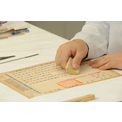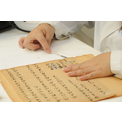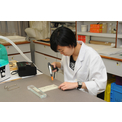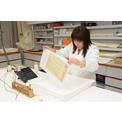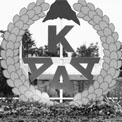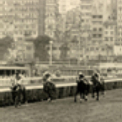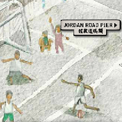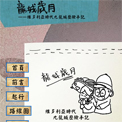 Collections
Collections Hong Kong, Benevolent City: Tung Wah and the Growth of Chinese Communities
Hong Kong, Benevolent City: Tung Wah and the Growth of Chinese Communities Conservation and Transmission
Conservation and Transmission Tung Wah Coffin Home Archives Restoration Project
Tung Wah Coffin Home Archives Restoration Project
1. Introduction
With a mission to collect, conserve and protect its rich cultural heritage, the Tung Wah Museum, a part of the Tung Wah Group of Hospitals, has embarked on various conservation projects to restore their culturally and historically significant archives since 2000. Among these conservation endeavours, the scale and scope of the “Tung Wah Coffin Home Archives Restoration Project” stands out as the most extensive and comprehensive. Apart from digitizing over 20,000 documents within the archives, two paper conservation specialists were engaged in 2009 to support the Museum’s efforts to conserve the archival materials as a cultural legacy for future generations.
2. Surface dry cleaning
Foreign grime, dirt, soot and mould deposited on archives disfigures and harms the surface of paper objects. First and foremost, the archives have to be surface-cleaned to remove undesirable accretions.
With the combined use of chemical sponges, soft brushes and suction-adjustable mini-vacuum cleaner, surface dirt is loosened and subsequently removed. This step not only arrests possible staining or damage to the objects, but also facilitates the subsequent process of conservation.
3. Removing inferior backing
Many of its items in the archives have been glued to some highly acidic backing papers which is highly unfavourable to long-term preservation. Over time, the acidic substances released from the backings damage paper cellulose, causing it to yellow and become brittle.
For this reason, inferior backing sheets have to be removed before the paper archives can be relined or encapsulated in quality sleeves for long-term storage. Besides using a spatula or a poultice of methyl cellulose to separate the archive from its backing by mechanical means, a combination of steam or a controlled amount of moisture is sometimes applied to soften the old glue to assist in the removal process.
4. Washing
Removing ingrained dirt from paper material is difficult by surface cleaning alone. Washing helps remove the dirt and reduce stains while simultaneously washing out acidic substances and degrading products that may have become lodged within the paper fibres.
Washing also serves to relax the fibres with the effect of lessening the distortion and brittleness of the paper. All colour media is tested for water sensitivity before the archive is washed in slightly alkaline de-ionized water to facilitate the removal of undesirable substances.
5. Use of moisture
The controlled use of moisture from an ultrasonic humidifier is an effective means to reduce dimensional distortions due to creases or folds. It also serves to flatten paper objects for tear realignment.
Very often, paper archives which have been tightly folded or rolled in storage become non-pliable or difficult to handle over time. Controlled application of moisture can help alleviate related problems. A conservator may also use heated moisture, generated from a preservation steam pencil, to remove the old adhesive tape previously applied to archive items.
6. Paper repair
To restore the structural stability of paper archives, conservators may find it necessary to mend tears and fill paper losses.
Tears are aligned under magnification, and subsequently mended in the reverse with narrow strips of long-fibre hand-made tissue paper using starch paste or methyl cellulose as adhesive.
Holes or paper losses can be filled with quality Chinese paper, paper pulp, or other select paper materials which are in agreement with the original paper substrates in terms of weight, texture, and colour tone by manual repair or with a leaf casing machine.
a. Manual mending of paper losses
A backing paper made of material compatible to the original substrate, but slightly larger than the size of the hole to be repaired, is traced out on a light table. The loss is filled from the back of the object with the use of starch paste. The filled-in areas can then be toned to make the repair less obtrusive.
b. Mending of paper losses with a leaf caster
The leaf casting process is meant to mend paper losses with purpose-prepared paper pulp under controlled suction. This process has the merit of filling all the holes on the paper object in a single operation. The paper archive should first be tested for colour fastness before it is wetted and placed over a filter screen in a specially designed treatment tank. Paper pulp suspended in slurry is then added and the fluid mixture is drawn through the paper substrate on the filter by means of a suction pump. Paper pulp is deposited on the screen support filling in existing holes or spaces as the mixture flows through the voids where paper substrates are missing. Upon air drying and flattening, the paper pulp sets and clings firmly to the original paper object in position.
7. Backing
Backing is optional but important step in the conservation process to provide extra support to the fragile archives. Conservators may choose to archive materials with a strong backing paper of lighter weight using starch paste, methyl cellulose, or a mixture of two. The backing helps reduce the risk of further damage to the paper archive and facilitates the handling of fragile objects.
